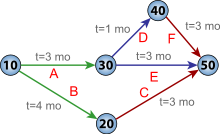The critical path method (CPM) is a project modeling technique developed in the late 1950s by Morgan R. Walker of DuPont and James E. Kelley, Jr. of Remington Rand. Kelley attributed the term “critical path” to the developers of the Program Evaluation and Review Technique which was developed at about the same time by Booz Allen Hamilton and the U.S. Navy. The precursors of what came to be known as Critical Path were developed and put into practice by DuPont between 1940 and 1943 and contributed to the success of the Manhattan Project. CPM is commonly used with all forms of projects, including construction, aerospace and defense, software development, research projects, product development, engineering, and plant maintenance, among others. Any project with interdependent activities can apply this method of mathematical analysis.
Critical path method
Posted by in critical path, fundamentals
Leave a comment
|
Project management
Posted by in fundamentals, PM
Leave a comment
|
Project management is the discipline of planning, organizing, motivating, and controlling resources to achieve specific goals. A project is a temporary endeavor with a defined beginning and end (usually time-constrained, and often constrained by funding or deliverables), undertaken to meet unique goals and objectives, typically to bring about beneficial change or added value. The temporary nature of projects stands in contrast with business as usual (or operations), which are repetitive, permanent, or semi-permanent functional activities to produce products or services. In practice, the management of these two systems is often quite different, and as such requires the development of distinct technical skills and management strategies.
The primary challenge of project management is to achieve all of the project goals and objectives while honoring the preconceived constraints. The primary constraints are scope, time, quality and budget. The secondary —and more ambitious— challenge is to optimize the allocation of necessary inputs and integrate them to meet pre-defined objectives.
